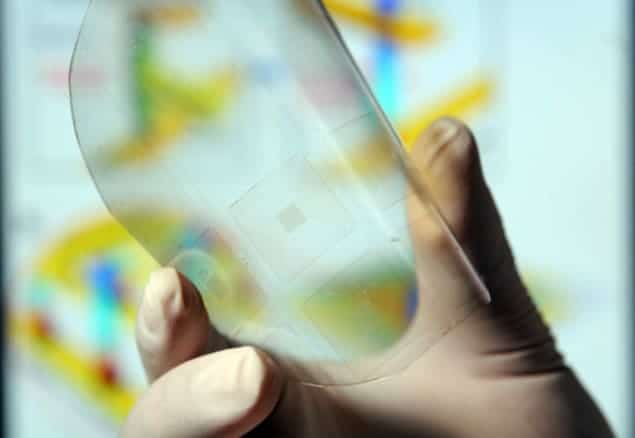
A team of engineers in the US has fabricated flexible, skin-like arrays of nanowire transistors that convert mechanical motion into electronic signals and are as sensitive as a human fingertip, according to the researchers. This means that the arrays could help robots to adjust intuitively the force they use to grasp things, be used in human prosthetics, as well as offer new ways for us to interface with a variety of electronic devices.
Reproducing a human sense of proprioceptive touch with electronics has proved difficult for roboticists. Existing tactile sensors tend to be made of materials with a resistivity that changes characteristically when touched, but the devices have frustratingly low resolutions – pixels of around 1 mm. The Georgia Institute of Technology team, led by Zhong Lin Wang, reduced the pixel size drastically, to 20–50 µm, and improved on resistive sensitivities by a factor of at least 30 by exploiting a unique physical phenomenon – the piezoelectric effect.
When a piezoelectric semiconductor is subject to mechanical strain, the symmetry of its component crystals gets distorted, creating a polarization charge along the length of the material. Wang used this principle a few years ago to create a new electrical component from bundles of zinc-oxide nanowires held vertically between electrodes: the piezoelectric transistor. Unlike conventional field-effect transistors – that have a current source, a drain and a gate electrode that controls the flow between them – the piezoelectric transistor comprises only source and drain electrodes. The internal piezoelectric polarization of the material acts as the gate, thus modulating the current by dominating how electrons flow at each end of the wire.
Rolling out the taxels
In the new work, Wang’s team fabricated a functional array of more than 8400 touch-sensitive transistors that the researchers dubbed “taxels”, for tactile pixels. Beginning with a thin, transparent substrate, the team laid parallel strips of indium tin oxide as the bottom electrode. These were spotted with contacts of gold – one spot for each nanowire to be constructed – before the nanowires themselves were synthesized vertically upward using a low-temperature hydrothermal chemical-growth technique. Last, gold contacts and the top electrode – strips laid crosswise to the bottom electrode – were added before the whole array was coated with a polymer to seal and protect it from moisture and corrosion.
Each transistor comprises a bundle of approximately 1500 nanowires, with each nanowire measuring about 500 nm in diameter. The sensors could detect pressure changes as small as 10 KPa – similar to a gentle touch such as typing on a keyboard. The finished “piezotronic transistor chip” may cover a modest area of less than a square centimetre but producing such an integrated array was a key step in transforming the concept into practical applications.
As well as offering robots a more adaptive sense of touch, the technology could improve the functional capability of human prosthetics and offer new ways for us to interact with electronics, for example with improved electronic-signature mapping. “When you sign your name, we can use these arrays to record the graphics, the force or pressure applied as you write your name, and also the speed with which you write it,” explains Wang. “This will make your signature much more functional, much more dimensional and much more secure.”
Mind-feeling
Kuniharu Takei, an engineer at Osaka Prefecture University in Japan who was not involved in the study, points out that the sensitivity of Wang’s array is on a par with the very best tactile-pressure sensors. Nevertheless, he considers it a “breakthrough” for human interactive electronics because the researchers managed to build a macro-scale device that is transparent and flexible. “With this device, it should be possible to design a touchscreen that really feels your mind, since it can feel the strength of tactile pressure,” he ventures. “If you’re angry or irritated, you may press the screen strongly; if you’re happy, you might touch the screen rhythmically.”
Zhenan Bao, a materials scientist at Stanford University, agrees that “the level of integration in this work is impressive”. In terms of mimicking the human sense of touch, though, she feels the device would benefit from a broader pressure-sensing range.
Wang identifies the team’s next goal as building higher-density, higher-sensitivity transistor chips. “We will also interface piezotronic transistors with silicon electronics and with biology,” he says. “I anticipate that in five years, we should see some very cool and novel applications.”
The research is published online in Science.



